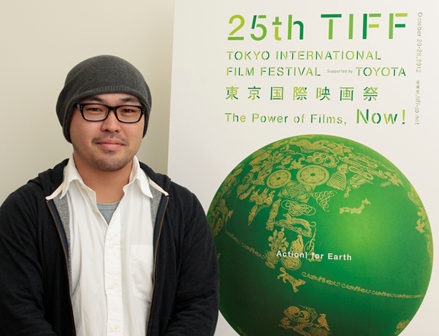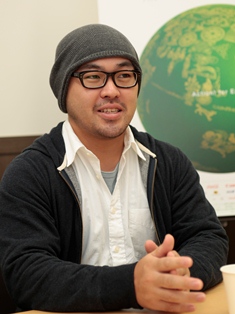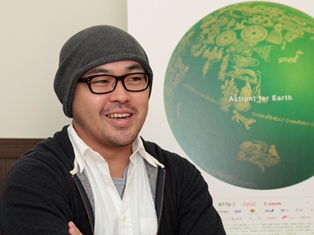Interview with Director Ryohei Yoshino: (Akaboshi)

“Akaboshi” is a thrilling and moving feature film debut by Ryohei Yoshino: The story revolves around a mother, taken in by a religious cult and her deteriorating state of mind viewed through the eyes of her young son.
— Is this your first feature film?
Ryohei Yoshino: Yes.
— But you’ve made short films? Other films before?
Yoshino: I’ve made a few short films.
— Are they a similar theme? Family dramas? Two or three character dramas?
Yoshino: The previous short, the one I made just before this one, is a drama, but with a middle-aged gay guy and a girl who can’t get guys. It’s a drama between those two.
— The name of this film?
Yoshino: “Tsuki no kage”. It was shown in the Tokyo Gay and Lesbian Film Festival.
— From you biography I see that you do technical work on film and also do radio work.
Yoshino: For the radio, I do a very small community FM radio program.
— DJ?
Yoshino: I do the planning and directing and editing, but no DJing
— All the actors were perfect. And I like to tell me a little about the actors. Let’s start with Romi.
Yoshino: She’s a very powerful woman, indeed, as you can see in the film. She’s a very popular voice actress, so she works on a very tight schedule. We had her come on the days when she didn’t have to work at her usual job. But she originally comes from theatre, so from the very start of rehearsals she put in all her effort there. So by the time we were rolling the camera, she was already tired, which was a little complicated during the shoot.
— Is she well-known in theatre also?
Yoshino: She may not be that well-known, but the amount of productions she’s worked on is a lot. So she has a lot of experience.
— Does she work with any particular theatre company?
Yoshino: She works with Theatrical Group EN (Engeki Shudan EN). Ken Watanabe also worked there. Yes, it’s a very well-known company.
— Of course there’s Aren, who’s amazing. Can you tell me about him?
Yoshino: We had him come to audition. But he’s been in a lot of Yukio Ninagawa’s stage productions. Whenever I’d ask him to do something, he’d take a totally different approach. So, I thought that he had to be the one for this part.
— How old is he?
Yoshino: He was 10 going on 11 [when the film was made].
— His smile is amazing. And the way he uses his smile, sometimes acting, sometimes natural. And for a young actor to have such awareness of something like his smile, I thought was quite amazing.
Yoshino: What’s wonderful about Aren is that you don’t really have to explain a lot to him. He just gets it. So, he does’t do too much. He doesn’t do too little. What he does is just perfect, so that helped a lot for me as a director.
— Have you ever directed children before this film?
Yoshino: Yes, previously in my short films. But even, often, I have a lot of contact with child actors.
— Why? How?
Yoshino: On the radio program I direct.
— And what about Vlada?
Yoshino: We had Vlada audition for the part as well. But the thing is, she couldn’t act at all. Together with her, we had to go over the details of the character and sort of develop the character together.
— Did you cast her for her appearance? For her look?
Yoshino: She’s had that sort of aura that adolescents have. That sort of disillusioned pouty aura. Also, I liked her profile. So, yes, that’s the reason I cast her. She has this lonesome look about her.
— And she also reminds a little of young Jody Foster.
Yoshino: She doesn’t have nearly the acting skills of Jody Foster.
— The look, and maybe the part, reminds me of the early Jody Foster roles.
Yoshino: Like “Taxi Driver.”

— The screenplay seems very tight. Was there any improvisation you worked with, or was it pretty well scripted?
Yoshino: I did it differently depending on the actors. With Romi and Aren I would have them do it a little creatively, do some ad libbing. With Vlada I had her read the script and I had to tell her where to pause, how to end her words.
— The story, the situation of the film, where did you get your inspiration for it?
Yoshino: The first Idea I had was to do a drama. I also wanted to make a feature length film. I also wanted to depict relationships that can be most hard or strenuous. And what’s harder than a mother who has to use her son to do these religious activities. I myself have had the experience of children coming and knocking on our door, trying to spread the word of whatever religion they’re part of, whatever cult they were a part of. And I remember that weren’t quite at ease while they were doing it, so I thought I can us this… as a movie.
— Regarding religious organizations, and this particular one in the movie, did you do research to find out about the philosophies, methods, ideas and how they work? Did you visit some religious cults?
Yoshino: Do you know of the Jehovah’s Witnesses? Speaking of Jehovah’s Witnesses, they do exist in Japan. Of course, they go under a different name. I interviewed seven or eight people who were ex-members of the cult, whose parents were part of the cult and they were brought up as children in the cult, but they’ve parted with this certain religion. So, I interviewed seven or eight of them.
— The mother’s use their children to open doors, to get people to listen to them, but you also show a slightly positive side of the cult that helps some of these people with their problems. Can you comment on that?
Yoshino: There are a lot of ways you can decipher it, especially the last scene. It really depends upon your perspective. Some people say it’s a happy ending. Some people say it’s not a happy ending at all. From the mother’s point of view, it’s a happy ending. Her son is with her at the end. But I, growing up as a little boy myself, empathize with the boy. I think it’s a tragic ending in that sense – when you look at it from the boy’s perspective. So, there are many ways you can see the film.
— What I was suggesting though is about Romi’s part, Yoshiko. She’s grieving, having a terrible time. She meets these people who help her and they ask her to go out and proselytize, but the immediate effect is she feels better. So, that’s positive, but then she changes it. She takes it to the extreme and goes crazy, pretty much. You show how the cult can have positive effects, but also very negative effects.
Yoshino: I think that the point is whether the audience can accept that mother as a human being. Accept what she’s going through. Accept what she’s doing.

— The other thing that also happens in this story, the children, Kanon (Vlada) and Tamotsu (Aren)… Tamotsu is pushed into being the father, being the responsible person and Vlada is going through changes, becoming a sexual woman and trying to control her own life, outside of the cult, but not doing very well. The idea of children growing up too fast, or before they’re allowed to be children is a strong theme. What can you tell me about this?
Yoshino: Exactly what you were talking about. I don’t know how this theme would be received internationally, but in Japan there is indeed a social current, which they call adult children, because parents nowadays are so juvenile that children have to shut down their own feelings. They have to become adults. They’re not allowed to be children anymore. So, that’s been a social issue for a while here. In that sense Tamotsu and Kanon, together as a set are a symbol of what’s happening with children nowadays, as a result becoming what we call adult children.
— Kanon introduces the idea of the Akaboshi, the guiding star, but by the end the star has disappeared. She leaves for Osaka and looks at the sky and just sees buildings. The little boy goes home. The sky is filled with lots of stars, nothing is guiding him anymore. This makes me feel it’s a very strong tragedy.
Yoshino: Kanon’s sky is different than the boy’s. What I wanted to depict was all the lights in the sky… you won’t be able to see them because of the city lights. That’s what I wanted to do with Kanon’s sky. But though she can’t see the stars in the sky, she still seeks them. I wanted to symbolize that she’s still looking. She’s still yearning for her father. Or a father figure.
— The other thing that comes up is the bullying of little Tamotsu and how he reacts to that.
Yoshino: I think in reality it’s a lot harsher than what you see in the film. Plus, now days, kids use the internet to bully, so there’s really no release or escape. In that sense it’s a lot harsher.
— When you were growing up, were you bullied?
Yoshino: I personally didn’t have that experience, but it happens everywhere, in every school.
— I think it happens with all little boys, even if we may not remember it very well. Children develop their power structures and hierarchies.
Yoshino: But I feel sorry for today’s children because of the Internet. If you’re bullied on the Internet the world sees that. A while ago, you could just run home and that would be your safe place. Now, there’s really no escape.
— And so both of the children, their father’s are gone. One’s disappeared, the other has killed himself. It affects them deeply. Kanon is still searching, still searching for that father figure, whereas for Tamotsu-kun, there’s no father anymore and he’s left on his own.
Yoshino: What I really wanted to depict was… in Japanese society today there’s really no father in the house, at home. So what these two kids are going through, if you have to identify it, is happening in Japan all over.
— But Kanon does have step-parents, at least who appear to be kind and nice and love her. Yet, she rejects them, to find her real father, perhaps, or any number of men that she has sexual relationships with. Kanon rejects her step-parents, even though they are good to her. That’s a tragic thing she does.
Yoshino: In creating the background of Kanon’s character, I was thinking that these step-parents were the kind of people who after Kanon left, maybe a year or so later, they will probably have forgotten about her and maybe even adopted another child. It’s not ill-intended at all. But it can have tragic effects.
— So, you’ve built background stories for all these characters?
Yoshino: Yes, in writing scripts I have a resume for each character. I create a resume for each character, so it’s very detailed, though it’s not shown in the film.
— Background, what comes before and what comes after. Is that in your mind?
Yoshino: All that is awaiting Tamotsu is tragedy.
— I don’t see his mother changing. I’m going to go a little off subject here. Who are the filmmakers, artists and writers that have inspired and influence you in general and for this film specifically?
Yoshino: For this film I told the D.P. to look at three films. One was Darren Arnofsky’s “The Wrestler.” The second was Lee Chang-dong’s “Secret Sunshine.” And the third was Jun Ichikawa’s “Osaka Story.”
— I don’t see “The Wrestler” in your film.
Yoshino: There’s a scene where Tamotsu leaves the school building and the bullies call out to him. And you see his back. And that’s sort of like Mickey Rourke.
(Interview by Nicholas Vroman)



















